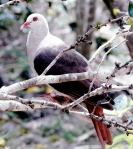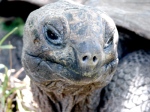The best thing about recording a giant tortoise is that it can’t easily get away from you, nor does it have any inclination to do so. However, a quarter ton of muscle and shell can be persuasive when it wants you to move out of its particular path of grazing. Occasionally, it grunts or groans as it slowly pulls its mass along in the midday heat. These are the sounds that I am trying to capture as I sit in the grass and weeds in front of him, parabola pointed at his indefatigable mouth. I watch as he briefly pauses from his incessant crunching of grass and dead leaves to inspect a small plant in front of him. I recognize the plant as Gastonia Mauritania, one of the critically endangered plants endemic to Mauritius. The tortoise cautiously mouths one of the long, skinny leaves and decides against it, resuming his activities with the grass and dead leaves.
This action is loaded with a heavy significance. In fact, it’s one of the reasons that the tortoise is even here at all. Two species of giant tortoise used to exist on Mauritius (both now extinct). Consequently, Gastonia evolved an effective means to deter these herbivores. As a juvenile, the plant produces long, thin leaves striped with bright red veins that giant tortoises dislike. As the plant matures, and reaches a height safely out of the reach of the tortoises, the veins disappear and the leaves become broader allowing more surface area for the plant to absorb nutrients.
The tortoise that I am recording is from Aldabra. It has been brought (along with dozens of others) to Mauritius to fill the void created by the disappearance of the extinct species. And they seem to be doing their job very well. They prefer the invasive, alien plant species over the endemics, and the endemics that they do eat enjoy the benefit of tortoise seed dispersal.
I am on Ile Aux Aigrettes, a small island about one kilometer off the coast of southeastern Mauritius. The island is owned by the Mauritian Wildlife Foundation and it is their intention to return the island as closely as possible to a state before human contact was made on Mauritius. Tortoise introduction is just one of many projects facilitating this goal. Introduced populations of Pink Pigeons, Mauritius Fodys and Mauritius Olive White-Eyes are doing well on the island. In addition to their introduction strategies, M.W.F. is also vigorously working on an island-wide elimination of all alien species, and, so far, the project is going well.
The Pink Pigeons and Mauritius Fody seem to be everywhere and I hurriedly get my gear out. Within a few minutes I have the microphone pointed at a male pigeon as he walks along the forest floor courting a female. With his chest feathers puffed out, he walks behind her rather awkwardly and gifting me with a great example of his mating call. The pigeons are quite ecologically naive and I find myself able to get within a few feet of them. They are striking and much larger than I anticipated. Their dark grey wings enfold around a light pink head and torso highlighted by rich, rust colored tail feathers. They sit lazily in low tree branches, or on the ground, or perched on the supplemental feeders the M.W.F. has provided for them all time making their deep, beautiful “hoo-hooOOOooo” call.
I point the parabola at one bird as it flies towards the cone-shaped tin feeder, but instead of landing on one of the perches conveniently placed near the dispersal opening, it lands directly on its pointed top. It stands there looking at me, trying to gain its balance unsuccessfully. My microphone picks up the scratching sounds as the bird tries to gain traction on the tin. The bird is still looking at me as it begins sliding down the side of the cone-shaped roof and finally falls with a thud to the ground below. It stands up dazed and slowly walks away. I’m perplexed by this behavior and look down at my recorder to confirm that it was recording. I listen back to it and wonder if anyone would ever be interested in listening to a Pink Pigeon falling off of a bird feeder. I shrug my shoulder and begin recording Fodys.
The Fodys are even more cooperative. There are dozens of them flying around the feeder. In the sunlight, I can only describe the males as flying jewels. The brilliant red is almost blinding. I watch the subtle intricacies of their courtship behavior and begin compiling a large amount of recordings. After some time, the birds (especially the females) become curious and start moving closer towards me. I’m forced to turn the gain down on my recorder as the proximity of their shrill and blasting chirps max out my levels. One of the birds almost decides to use my microphone as a perch.
During my eight hours on the island, I manage to collect a impressive amount of recordings. If only all of my targets could be this cooperative.




Leave a comment